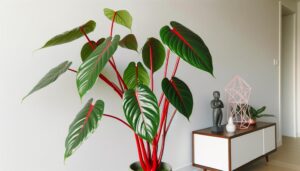When Should I Up-Pot a Philodendron Congo?
Philodendron Congo should be up-potted when it shows signs such as stunted growth, yellowing leaves, or visible root deformation and spiraling. Root bound conditions restrict vegetative growth and nutrient absorption, hampering photosynthesis and overall plant health.
Optimal up-potting should be done in spring or early summer, aligned with peak metabolic activity, to minimize transplant shock and maximize root expansion. Container selection should prioritize adequate drainage and size incrementally by 1-2 inches.
Post-transplant care requires consistent moisture, indirect bright light, and appropriate humidity levels to ensure strong recovery and growth. Discover further strategies to enhance your plant's vitality.
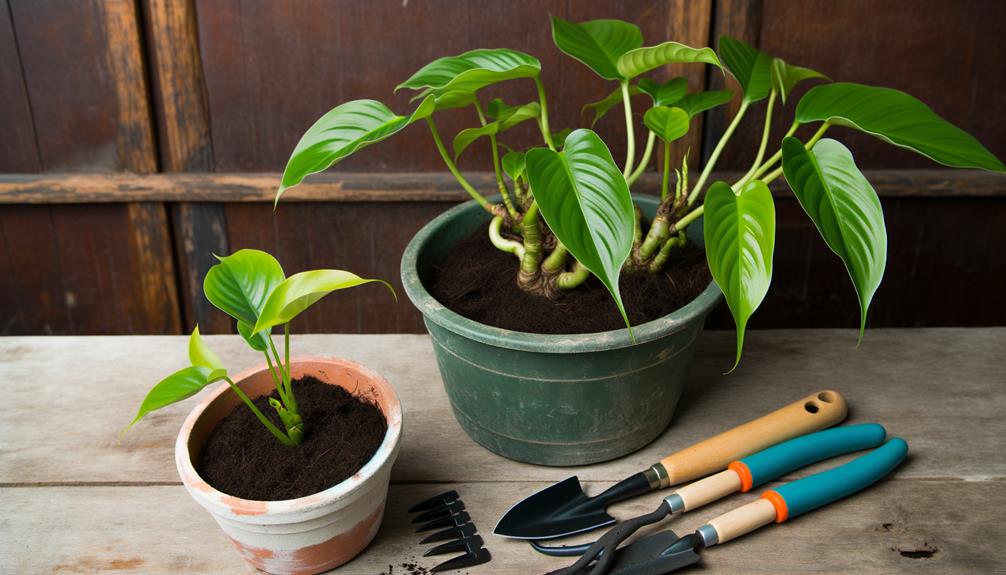
Key Takeaways
- Up-pot when you observe stunted growth and yellowing leaves indicating root bound conditions.
- Spring and early summer are the best times for up-potting to match peak metabolic activities.
- Inspect roots for spiraling or deformation as signs that up-potting is necessary.
- Choose a new container 1-2 inches larger to allow for root expansion.
- Ensure the new pot has adequate drainage to prevent waterlogging and support healthy root growth.
Root Bound Symptoms

Root bound symptoms in a Philodendron Congo manifest through stunted growth, yellowing leaves, and deformed roots encircling the pot's interior. This condition hampers the plant's ability to absorb necessary nutrients and water, leading to chlorosis and necrosis. Visual inspection often reveals roots spiraling around the pot's perimeter, creating a dense, matted structure.
This constriction restricts root elongation and disrupts normal physiological processes. Additionally, the compacted root mass can lead to poor aeration, resulting in hypoxic conditions detrimental to root health. The plant's overall vitality declines, and signs of nutrient deficiencies, such as interveinal chlorosis, may become evident.
Addressing these symptoms promptly is essential to restore optimal growth conditions and ensure the plant's long-term health and vigor.
Slowed Growth
In addition to the physical symptoms of root bound conditions, a notable indicator of the need to up-pot a Philodendron Congo is the marked slowdown in its vegetative growth rate. This deceleration occurs as the plant's roots become increasingly constrained, limiting their ability to absorb essential nutrients and water efficiently.
Consequently, photosynthesis is impaired, reducing the plant's capacity for energy production and biomass accumulation. Observing elongated internodes, reduced leaf size, or pale foliage can further confirm slowed growth. These symptoms signify that the plant's root system is unable to support its current metabolic demands.
To mitigate this issue, up-potting into a larger container will provide the necessary space for root expansion, thereby restoring ideal growth conditions.
Watering Frequency
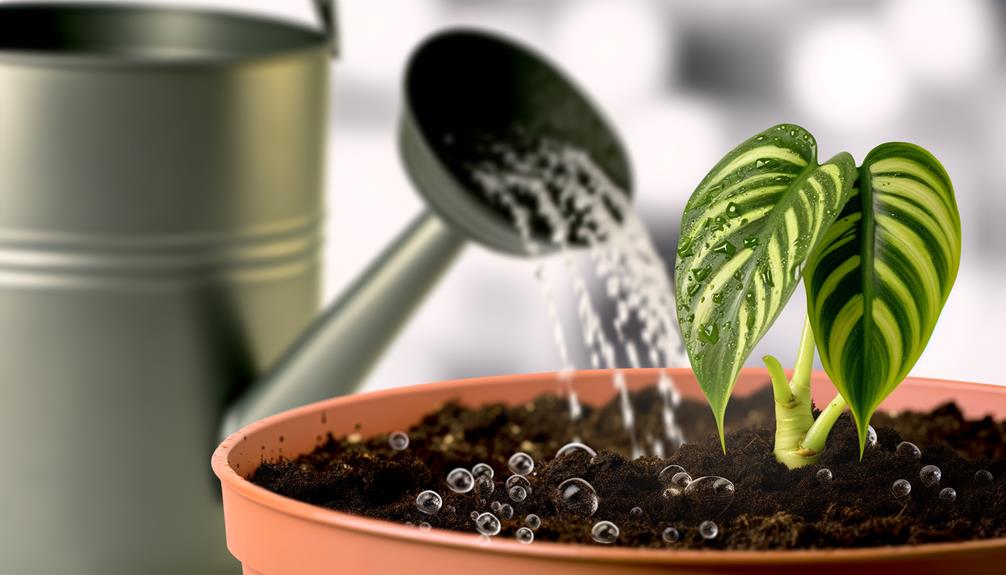
Watering frequency for a Philodendron Congo should be calibrated to maintain ideal soil moisture, avoiding both desiccation and waterlogging.
An ideal watering schedule involves irrigating the plant when the top inch of soil becomes dry, ensuring sufficient hydration without causing root rot.
Signs of overwatering include yellowing leaves, a musty odor from the soil, and potential fungal growth, which necessitate immediate corrective measures.
Ideal Watering Schedule
Ideal hydration for a Philodendron Congo involves maintaining a consistent watering schedule that aligns with its growth patterns and environmental conditions. This species thrives with a balance between moisture and aeration in the soil.
During the active growth phase, typically spring through early autumn, the substrate should remain moderately moist. This requires watering approximately once weekly, contingent on the ambient temperature and humidity levels. Employing a soil moisture meter can facilitate precise monitoring, ensuring the root zone does not desiccate or become waterlogged.
In dormancy periods, particularly late autumn through winter, reduce irrigation frequency to bi-weekly or even tri-weekly intervals. This adjustment mitigates root rot risks while accommodating the plant's reduced metabolic demand.
Signs of Overwatering
Understanding the best watering schedule is key, yet it is equally important to recognize the signs of overwatering to prevent harmful effects on the Philodendron Congo.
Symptoms of overwatering often include chlorosis, where the leaves turn yellow due to impaired chlorophyll synthesis. Additionally, root rot, a condition caused by anaerobic bacteria thriving in waterlogged soil, may manifest, leading to wilting despite moist substrate conditions.
The presence of edema, characterized by blister-like formations on leaves, is another indicator of excessive water absorption. Observing the soil's moisture content using a hygrometer can help in evaluating the need for irrigation.
Proactive monitoring and adjusting watering frequency in response to these physiological and environmental cues are essential for the plant's best health and growth.
Soil Condition
Evaluating soil condition is critical for determining the appropriate timing for up-potting a Philodendron Congo. Key factors to assess include the drainage and aeration levels, which impact root oxygenation and water retention, and soil nutrient depletion, which can hinder plant growth.
Additionally, root bound indicators, such as roots encircling the pot or emerging through drainage holes, require a larger container to prevent restriction of root expansion.
Drainage and Aeration Levels
Proper drainage and aeration are essential for maintaining ideal soil conditions. They guarantee that the roots of a Philodendron Congo receive sufficient oxygen and prevent waterlogging. Adequate drainage facilitates the removal of excess water, which is important to avoid root rot caused by anaerobic conditions.
Aeration, achieved through a well-structured soil mix containing components such as perlite, pine bark, or coarse sand, ensures the diffusion of oxygen to root tissues. Regular assessment of the potting medium is crucial. Compacted or water-retentive soil diminishes oxygen availability and impedes root respiration.
Employing containers with drainage holes and periodically loosening the soil matrix can greatly enhance root health and contribute to the overall vigor of the plant.
Soil Nutrient Depletion
In addition to drainage and aeration, monitoring soil nutrient depletion is essential for ensuring the sustained health and growth of a Philodendron Congo. Nutrient-poor soil can lead to stunted development and diminished vigor. Essential macro and micronutrients, including nitrogen, phosphorus, and potassium, deplete over time due to plant uptake and leaching.
A soil analysis can quantify nutrient levels and identify deficiencies. Symptoms of nutrient depletion manifest as chlorosis, necrosis, and reduced leaf size. Regularly supplementing with balanced fertilizers can mitigate nutrient loss, but over time, the soil structure itself becomes less capable of retaining nutrients and moisture.
Consequently, up-potting becomes necessary to provide a fresh, nutrient-rich medium that supports robust growth and best physiological function.
Root Bound Indicators
One critical indicator that a Philodendron Congo requires up-potting is the presence of a root-bound condition, where roots become densely packed and encircle the pot's interior. This phenomenon greatly hinders the plant's ability to uptake water and nutrients effectively. Observing the soil condition can provide valuable insights.
Compacted Soil: Soil appears tightly packed, reducing aeration and water permeability.
Visible Roots: Roots protrude from drainage holes or the soil surface, indicating inadequate space.
Water Runoff: Water rapidly drains from the pot, indicating soil with a reduced capacity to retain moisture.
These signs collectively suggest that the current pot is inadequate for healthy root expansion, necessitating an upgrade to a larger container to maintain the plant's health.
Container Size
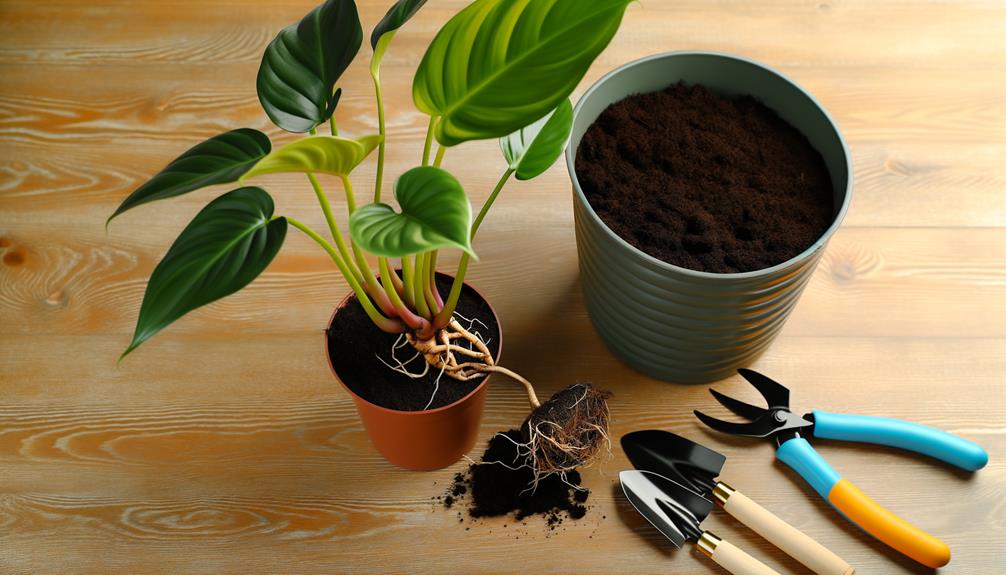
Determining the appropriate container size for a Philodendron Congo is important to secure ideal root development and overall plant health. Selecting a container that is too large can lead to waterlogging and root rot due to excessive moisture retention. Conversely, a pot that is too small may restrict root expansion, stunting growth and reducing nutrient uptake.
It is advisable to up-pot to a container that is 1-2 inches larger in diameter than the current one. This incremental increase provides sufficient space for root proliferation without overwhelming the plant. Additionally, make sure the new container has adequate drainage holes to prevent water accumulation, thereby promoting peak aeration and root health.
Employing a well-draining potting mix further facilitates optimal root conditions.
Seasonal Timing
Ideal root development facilitated by suitable container sizing should be complemented by considering the seasonal timing for up-potting a Philodendron Congo, as certain periods of the year are more conducive to minimizing transplant shock and promoting vigorous growth.
The best seasons for up-potting are spring and early summer when the plant's metabolic activities are at their peak. During this time, enhanced photosynthetic efficiency and increased light availability support robust root establishment. Conversely, up-potting during late fall or winter is ill-advised due to dormancy and reduced physiological activity.
Key benefits of up-potting in the appropriate season:
- Enhanced Root Expansion: Facilitates quicker adaptation to new soil.
- Robust Growth: Encourages active vegetative growth.
- Reduced Stress: Minimizes the risk of transplant shock.
Transplant Shock Prevention
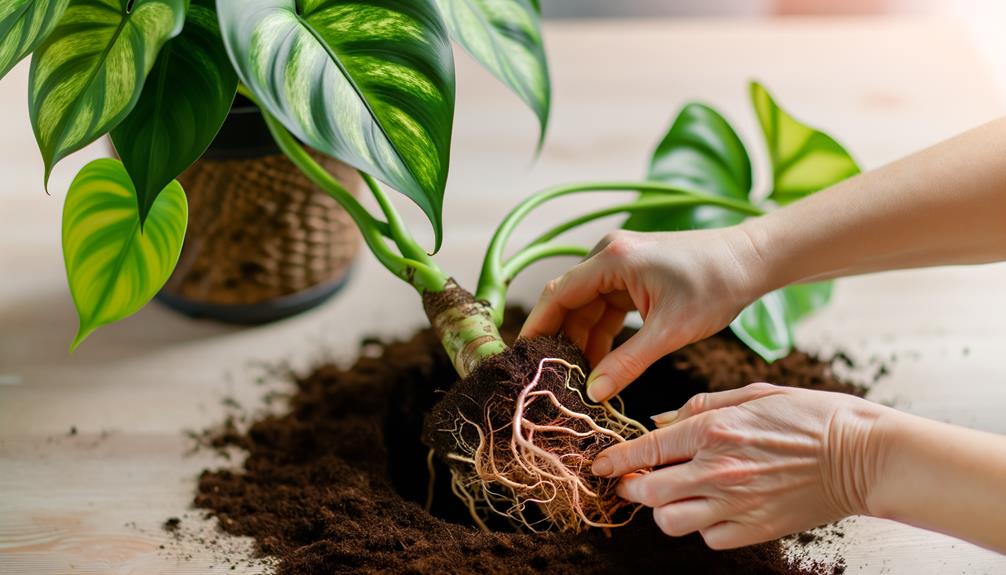
To lessen the risk of transplant shock when up-potting a Philodendron Congo, it is crucial to make sure that the plant's root system remains undisturbed and properly hydrated during the process. Utilizing a combination of careful handling techniques and ideal hydration strategies can greatly reduce the occurrence of transplant shock. Root damage must be minimized by gently loosening the soil around the roots and making sure the root ball remains intact. Hydration is essential; water the plant thoroughly before and after transplanting to maintain turgor pressure and cellular function.
| Approach | Purpose |
|---|---|
| Delicate Root Handling | Reduce root damage and stress |
| Thorough Pre-Watering | Sustain sufficient cellular hydration |
| Immediate Post-Watering | Restore moisture balance and turgidity |
Following these principles guarantees the Philodendron Congo adjusts smoothly to its new surroundings.
Choosing the Right Pot
Selecting an appropriately sized and well-draining pot is crucial for promoting ideal root health and robust growth in a Philodendron Congo. The chosen pot must accommodate the plant's expanding root system while preventing waterlogging, which can lead to root rot.
To enhance plant health, consider the following:
- Size: Choose a pot that is 1-2 inches larger in diameter than the current one to provide ample space for root expansion without causing stress.
- Material: Opt for materials such as terracotta or ceramic that offer breathability and evaporative cooling, which is advantageous for root aeration.
- Drainage: Make sure the pot has multiple drainage holes to facilitate proper water flow and prevent moisture accumulation.
Post-Transplant Care
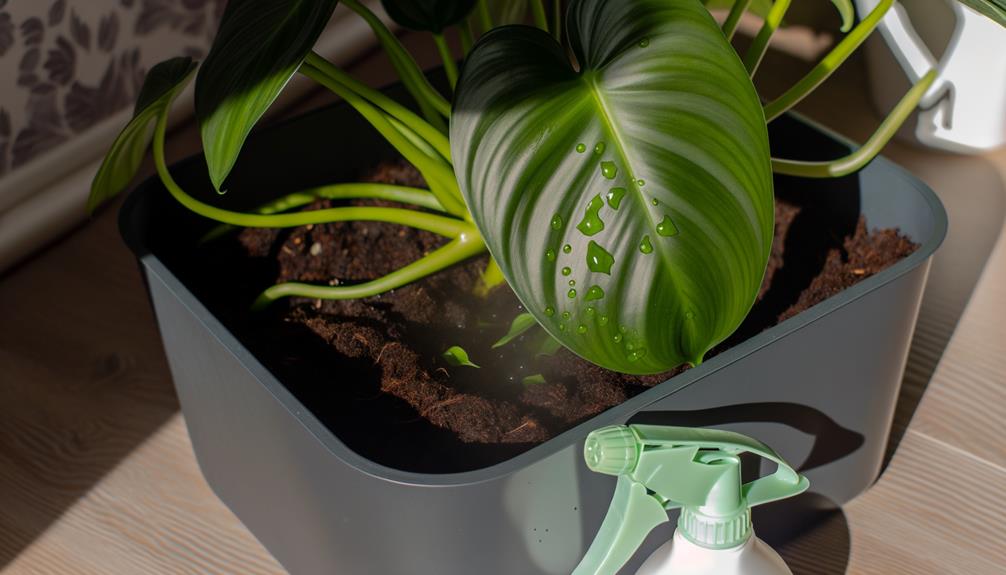
After properly selecting and potting your Philodendron Congo, meticulous attention to post-transplant care is essential to guarantee the plant adapts successfully and continues to thrive. Securing ideal conditions post-transplant involves monitoring soil moisture, light exposure, and temperature. Water the plant thoroughly, allowing excess to drain, to prevent root rot. Position the plant in indirect sunlight, avoiding direct sun that could stress the foliage. Maintain ambient temperatures between 65-80°F to support metabolic functions.
| Factor | Best Range | Notes |
|---|---|---|
| Soil Moisture | Evenly moist, not waterlogged | Check weekly for moisture consistency |
| Light Exposure | Indirect bright light | Avoid direct sunlight |
| Temperature | 65-80°F | Maintain stable temperatures |
| Humidity | 60-70% | Use a humidifier if necessary |
| Fertilization | Monthly during growth | Use balanced, water-soluble fertilizer |
Regularly monitor these parameters to guarantee a seamless adaptation and robust growth.
Conclusion
To sum up, the best timing for up-potting a Philodendron Congo can be determined by closely monitoring certain signs such as root-bound symptoms, slowed growth, increased watering frequency, and deteriorating soil conditions. Paying attention to container size, seasonal timing, and taking steps to prevent transplant shock are crucial.
Choosing a suitably sized pot and offering careful post-transplant care will guarantee the plant thrives. Similar to a finely tuned instrument, a correctly up-potted Philodendron Congo will thrive in harmonious growth.


